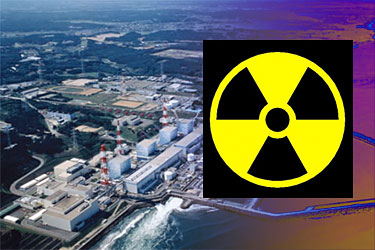Radioactivity Detected 60 Miles From Fukushima Power Plant by US Navy, Full Meltdown Now
Tyler Durden
Zero Hedge
March 14, 2011
 The latest in an endless escalation of bad news comes from Seattle Times: “Pentagon officials reported Sunday that helicopters flying 60 miles from the Fukushima Daiichi nuclear plant picked up small amounts of radioactive particulates — still being analyzed, but presumed to include cesium-137 and iodine-121 — suggesting widening environmental contamination. The detection of the highly radioactive elements heralds the beginning of an ecological and human tragedy. The two radioactive isotopes can mean only one thing: One or more of the reactor cores is badly damaged and at least partially melted down.” If true, this also means that the Japanese government is blatantly lying to its people and the world, in its relentless determination to prevent panic and to pursue the party line that after two massive blasts the cores are still stable. And judging by the time stamp, this was announced before last night’s second blast: if radioactivity had spread then, how about now? And who can blame Americans and people around the world who are concerned that radiation may be coming their way if nobody is to be trusted.
The latest in an endless escalation of bad news comes from Seattle Times: “Pentagon officials reported Sunday that helicopters flying 60 miles from the Fukushima Daiichi nuclear plant picked up small amounts of radioactive particulates — still being analyzed, but presumed to include cesium-137 and iodine-121 — suggesting widening environmental contamination. The detection of the highly radioactive elements heralds the beginning of an ecological and human tragedy. The two radioactive isotopes can mean only one thing: One or more of the reactor cores is badly damaged and at least partially melted down.” If true, this also means that the Japanese government is blatantly lying to its people and the world, in its relentless determination to prevent panic and to pursue the party line that after two massive blasts the cores are still stable. And judging by the time stamp, this was announced before last night’s second blast: if radioactivity had spread then, how about now? And who can blame Americans and people around the world who are concerned that radiation may be coming their way if nobody is to be trusted.
More Seattle Times:
Japanese reactor operators now have little choice but to periodically release radioactive steam until the radioactive elements in the fuel of the stricken reactors stop generating intense heat, a process that can continue for a year or more even after fission has stopped.
In the best case, operators will pump enough seawater and other coolants to squelch overheating. Such a success would prevent further releases of radiation beyond the unknown amount spewed into the air by controlled venting and the explosion of a reactor containment building.
In such a scenario, the only casualties would probably be the handful of plant workers reported Sunday to be suffering from acute radiation sickness.
If the last-ditch efforts to cool the reactors fail, the heavy cylindrical cores — each containing tons of radioactive fuel — could flare to hotter than 4,000 degrees and melt through the layers of steel and cement engineered to contain them.
Such a meltdown may be under way, said Arnie Gundersen, chief engineer at the consulting firm Fairewinds Associates. Gundersen helps oversee the Vermont Yankee nuclear plant, whose reactors are the same vintage and design as those of the stricken Japanese reactor.
If a full meltdown occurs, a huge molten lump of radioactive material would burn through all containment, destroy the building and fall to the ground, exposed. A toxic stew of exotic radioactive particles would then spread on the wind and rain.
And keeping the news going is the update from NHK that at least 11 people have died in the second blast reported earlier:
At least eleven people died in a second explosion at the Fukushima nuclear plant in north-eastern Japan on Monday, NHK TV said.
The build-up of hydrogen caused reactor no. 3 to explode at around 02:00 GMT but the government’s top spokesman, Yukio Edano, said its core was still intact. He said there was a “low possibility” of a rise in radiation levels near the damaged plant.
A blast occurred in the plant’s reactor no. 1 on Saturday.
The plant’s operator, Tokyo Electric Power Co., told the TV station that the cooling system at reactor no. 2 has failed.
(Reuters) - Nuclear fuel rods at a quake-stricken Japanese nuclear reactor are now fully exposed, Jiji news agency said, quoting the plant's operator, Tokyo Eletcric Power Co .
Comment
-
Comment by TheLasersShadow on March 14, 2011 at 8:45pm
-
Meltdown alert at Japan reactor (BBC)
Technicians are battling to stabilise a third reactor at a quake-stricken Japanese nuclear plant that has been rocked by a second blast in three days.
Sea water is being pumped into reactor 2 at the Fukushima Daiichi plant after its fuel rods were fully exposed twice.
"Destroying the New World Order"
THANK YOU FOR SUPPORTING THE SITE!
Latest Activity
- Top News
- ·
- Everything
What was the Significance of the F-94 C and What role in History?
FLUORIDEGATE: An American Tragedy. a film by Dr. David Kennedy
Rendezvous With The Unknown
Shadows in the Wind
Mossad: we create a pretend world, we are a global production company... the world is our stage
The Alvin II Encounter: Was There A Living Dinosaur Involved?
© 2025 Created by truth.
Powered by
![]()
You need to be a member of 12160 Social Network to add comments!
Join 12160 Social Network